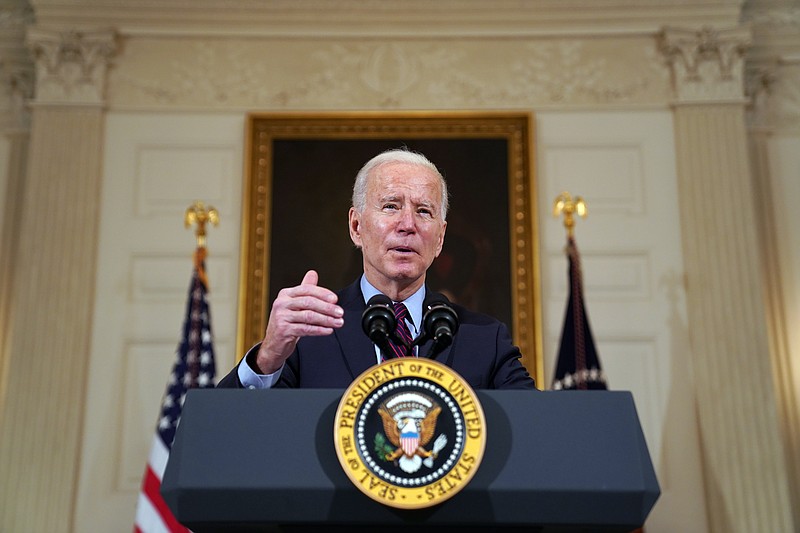"Tucked inside President Joe Biden's $1.9 trillion coronavirus relief plan is a seemingly radical notion that children should not grow up in poverty."
That's the first sentence of an Associated Press report, a portion of which appeared Tuesday in the Chattanooga Times Free Press on page A8.
"The Democratic plan would likely mark the most significant step in the fight against child poverty since LBJ's Great Society," said Daniel Hemel, a law professor at the University of Chicago, who noted that a family with two school-age children and no income would get $6,000 under the proposal.
This one-time - repeat, one-time - benefit is intended to help relieve millions of families hurt by the fallout from the coronavirus pandemic. Parents have lost their access to child care, pushing them out of the labor force and hindering the economic recovery, the AP reported. Children have gone without the classroom time needed for social and academic progress.
It's a reasonable rescue plan, especially as an immediate response to the pandemic that already has changed our lives for a year.
But the AP story correctly points out - albeit with some understatement - that the child tax credit expansion "might end up seeding the kind of lasting change that tends to bring a political fight."
Conservatives at the Heritage Foundation already are whining about "welfare," saying the plan "would discourage parents from working and would not reduce poverty as a result." Heritage accuses Democrats of "clearly using the COVID situation" to sneak "a reversal of welfare reform through the backdoor."
Liberals, on the other hand, view the plan as an investment in our pandemic-crushed economy and in children - perhaps even one that needs to stay in place beyond this year to ultimately improve people's lives. Elaine Maag, principal research associate at the Tax Policy Center, says: "It's not undoing welfare reform - it's just correcting an inequity in how we treat low-income children versus high-income children."
History shows us that if we can invest in these children today, later on we'll see benefits from those investments. Each dollar spent on health insurance programs for children led to a $1.78 return for the government, according to a 2020 paper by Harvard University economists. And if we don't spend, the poor will still cost us. And cost us more, down the road.
With all this political zigzagging, we haven't been able as a country to make up our minds on a policy and stick with it.
When Lyndon Johnson became president in 1963, nearly 25% of American children lived in poverty. The combination of LBJ's Great Society programs that included nutrition aid and preschool funding helped slash the child poverty rate to 14% by 1969, according to the Census Bureau.
But since then, driven by those zigzagging pro and con political ideas and gnawed away by increasingly conservative congresses and changing administrations, the child poverty rate has bounced up and down with the broader economy. It has never, however - repeat, never - fallen meaningfully below that 1969 level. In 2005, it was 19%; in 2010, 22%; in 2015, 21%; in 2019, 17%. Imagine what it is right now after nearly 30 million people lost jobs as the pandemic hit.
The poverty line is about $26,246 for a family of four, and researchers at Columbia University estimated that President Biden's entire $1.9 trillion relief plan would slash the child poverty rate to less than 7% this year and likely help about 20 million lower-income people.
When Biden talked Friday about his proposal, he said the spending, which includes funding for school reopenings, child care and other programs to help our youngest Americans, would ultimately lead to durable economic gains.
"The simple truth is, if we make these investments now, with interest rates at historic lows, we'll generate more growth, higher incomes, a stronger economy and our nation's finances will be in a stronger position as well," the president said.
Families would receive up to $3,600 annually for each child under age 6 and as much as $3,000 for those up to 17. The tax credit would start to phase out for individual parents earning more than $75,000 and couples making $150,000. Payments of the credit would be made monthly, even to families who owe no federal income taxes - a change from current policy.
It's the kind of investment we haven't seen in a while. Even under the Obama administration, the Republican-controlled Congress systematically targeted for extinction anything that might strengthen the safety net for impoverished people, pulling away at the food stamp and temporary-welfare-assistance. States like Tennessee instituted policies requiring at least part-time work in exchange for assistance. You may recall former U.S. Rep. Paul Ryan saying in 2012: "We don't want to turn the safety net into a hammock that lulls able-bodied people to lives of dependency and complacency ..."
Does anyone really think that a family with two school-age children and no income mentioned here earlier could get by for a year on $6,000? How exactly is that bump going to dissuade the adults in the household from seeking and keeping a job? These people can't get comfortable in a safety net hammock that they're still falling through.
It seems that whenever we might near even half success in lowering child poverty in the richest country in the world (and the one in 2020 with the biggest wealth gap), we scare ourselves into being penny wise and pound foolish.
To borrow from another old cliche, we snatch defeat straight out of the jaws of victory.
